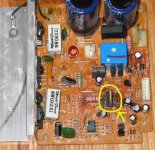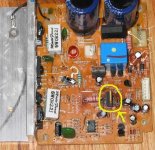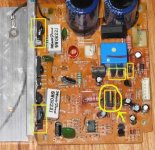Hi Guys.
My Hsu Research sub made a buzzing noise and then was all quiet. Fuse was blown. The replaced fuse blew as soon as I turned it on. I opened up the plate amp and noticed the circuit board burnt beneath a transistor. I replaced that transistor and tried but it blew the fuse again.
I'm attaching a pic (I was surprised to see the size of the amp module, so small!!). I checked the power trafo and it's putting out +/- 38 V. Please help fixing or salvaging this.
My Hsu Research sub made a buzzing noise and then was all quiet. Fuse was blown. The replaced fuse blew as soon as I turned it on. I opened up the plate amp and noticed the circuit board burnt beneath a transistor. I replaced that transistor and tried but it blew the fuse again.
I'm attaching a pic (I was surprised to see the size of the amp module, so small!!). I checked the power trafo and it's putting out +/- 38 V. Please help fixing or salvaging this.
Attachments
I would guess you have a short in one of your output transistors.
I am only guessing but it looks like a driver for the output transistors and if that one burns my first guess is that the output transistor is pulling too much current.
This is completely without knowing the schematic of your amplifier.
A picture of the other side of the PCM could help but a schematic would make it easier.
I am only guessing but it looks like a driver for the output transistors and if that one burns my first guess is that the output transistor is pulling too much current.
This is completely without knowing the schematic of your amplifier.
A picture of the other side of the PCM could help but a schematic would make it easier.
What are those IC105 104. Fixed voltage regulators?
What are they driving to cause the heat? The 105 is a bit white which if i am not mistaken indicates that it has been hot.
Could be a short in that one too?
What are they driving to cause the heat? The 105 is a bit white which if i am not mistaken indicates that it has been hot.
Could be a short in that one too?
Thanks for the input guys.
hjelm, 105 is not white, it's just flash reflection.
I tested the diodes on the board and one seems defective (reads both ways). Should I replace this or should I test other components as well before replacing the diode?
How can I test the bridge rectifier and the transistors? Using a continuity tester on the transistors, both of them look like they are shorted. The transistors are Toshiba C5198 and Tosh A1941.
Thanks in advance for all the help.
hjelm, 105 is not white, it's just flash reflection.
I tested the diodes on the board and one seems defective (reads both ways). Should I replace this or should I test other components as well before replacing the diode?
How can I test the bridge rectifier and the transistors? Using a continuity tester on the transistors, both of them look like they are shorted. The transistors are Toshiba C5198 and Tosh A1941.
Thanks in advance for all the help.
Yes, I would check all the transistor and diode junctions before powering it up with new outputs. Also, I suggest running the power through a short lamp during power-up test.
It is an incandescent bulb which is temporarily connected in series with the power transformer primary for test purposes. Most of the time, I used a 60w 120v one because we have 120v AC mains over here. It limits the current that can be applied to a faulty circuit.
Short lamp is one of the best insurance Policies while repairing amps... I don't know why many people don't use them more.
Replace the outputs and drivers and then run the amp via the bulb. if the bulb stays lit then you have an issue, if it dies down after the initial charge-up, then pass some signal through the amp. All may be ok...
Usually a burnt out driver means a Collector to Base short on the outputs. The drivers do not usually die fast unless the otputs are dumping the rail voltages into them. The drivers usually blow the resistance feeding the base of the outputs first.... changing the outputs is THE first thing a tech looks at when fuses blow.
K-
Replace the outputs and drivers and then run the amp via the bulb. if the bulb stays lit then you have an issue, if it dies down after the initial charge-up, then pass some signal through the amp. All may be ok...
Usually a burnt out driver means a Collector to Base short on the outputs. The drivers do not usually die fast unless the otputs are dumping the rail voltages into them. The drivers usually blow the resistance feeding the base of the outputs first.... changing the outputs is THE first thing a tech looks at when fuses blow.
K-
OK guys, here is the latest:
I replaced the components highlited on the pic and tested it using the short lamp (40 Watt bulb).
When I switch the amp on, the bulb will turn on really bright and then stays lit. The transistors get real hot.
So there is still a problem. What else can I change? How to test the bridge rectifier?
I replaced the components highlited on the pic and tested it using the short lamp (40 Watt bulb).
When I switch the amp on, the bulb will turn on really bright and then stays lit. The transistors get real hot.
So there is still a problem. What else can I change? How to test the bridge rectifier?
Attachments
how did the old transistors measure??
You may have a shorted transformer or a shorted PSU filter Cap..
Ralph
You may have a shorted transformer or a shorted PSU filter Cap..
Ralph
Check the transistors prior to the burnt driver, chances are they are shorted too. A shorted input diff pair will cause boatloads of DC to be amplified at the outputs.
The old transistors WERE shorted.
I don't know what the other components on the heat sink are, may be a negative feed back trans?? I'll see if the replacements are available at Electronic City.
Transformer is fine, I measured +/- 38V.
Which would be the PSU filter cap? and how would one test it with a DMM?
Please help!! If you need more pics, let me know.
I don't know what the other components on the heat sink are, may be a negative feed back trans?? I'll see if the replacements are available at Electronic City.
Transformer is fine, I measured +/- 38V.
Which would be the PSU filter cap? and how would one test it with a DMM?
Please help!! If you need more pics, let me know.
Don't worry about the caps they rarely fail, first go for the transistors.
The other things that are usually mounted on heatsinks are:
Bias transistor and
Amplified bias Diode.
Both do thermal compensation for bias. Check those as well.
Then checl all resistors on the bases and the emmiters of all burnt transistors.
K-
The other things that are usually mounted on heatsinks are:
Bias transistor and
Amplified bias Diode.
Both do thermal compensation for bias. Check those as well.
Then checl all resistors on the bases and the emmiters of all burnt transistors.
K-
What's that IC in the middle?
It looks like an IC Power opAmp?!
If the outputs were shorted, chances are VERY high that whatever drives them is bad. If that multi-legged thing in the middle is an LM3886TF or similar, replace it. I can tell from the PC board there is no discrete driver section, and the only other audio component is a 4558 OpAmp.
It looks like an IC Power opAmp?!
If the outputs were shorted, chances are VERY high that whatever drives them is bad. If that multi-legged thing in the middle is an LM3886TF or similar, replace it. I can tell from the PC board there is no discrete driver section, and the only other audio component is a 4558 OpAmp.
You must still have faulty transistors. Also watch the emitter resistors, they have a tendancy to burn out when the transistors go, but may still look good.
The PSU caps and bridge will short, although seldom. But always a consideration when outputs are still good.. But big psu caps are unmeasurable with a DMM.. I use a Cap checker..
Ralph
The PSU caps and bridge will short, although seldom. But always a consideration when outputs are still good.. But big psu caps are unmeasurable with a DMM.. I use a Cap checker..
Ralph
(Update)
I was finally able to get it working 🙂
The big white resistors were shorted (lubbie's suggestion) which caused the output transistors to burn out, also the multilegged thingy. Replaced them all and now the amp is working well. Thank you all for the help.
Shajan
I was finally able to get it working 🙂
The big white resistors were shorted (lubbie's suggestion) which caused the output transistors to burn out, also the multilegged thingy. Replaced them all and now the amp is working well. Thank you all for the help.
Shajan
- Status
- Not open for further replies.
- Home
- Amplifiers
- Solid State
- Help! Fixing Amp.


